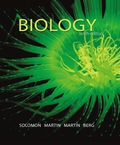
EBK BIOLOGY
10th Edition
ISBN: 8220100474729
Author: Martin
Publisher: Cengage Learning US
expand_more
expand_more
format_list_bulleted
Concept explainers
Question
Chapter 34, Problem 3TYU
Summary Introduction
Introduction: Plants are non-motile living beings that are capable of producing their own food by utilizing the sunlight and carbon dioxide. They form the kingdom Plantae that includes all the plants, such as trees, shrubs,
Expert Solution & Answer
Trending nowThis is a popular solution!

Students have asked these similar questions
Please draw in the missing answer, thank you
Please fill in all blank questions, Thank you
please fill in missing parts , thank you
Chapter 34 Solutions
EBK BIOLOGY
Ch. 34.1 - Prob. 1LOCh. 34.1 - Prob. 2LOCh. 34.1 - Prob. 3LOCh. 34.1 - Prob. 4LOCh. 34.1 - How are leaves adapted to conserve water?Ch. 34.1 - Prob. 2CCh. 34.1 - What are the two types of vascular tissue in a...Ch. 34.1 - How is the leaf organized to deliver the raw...Ch. 34.2 - Prob. 5LOCh. 34.2 - Prob. 6LO
Ch. 34.2 - How does blue light trigger stomatal opening?Ch. 34.2 - Prob. 2CCh. 34.3 - Discuss transpiration and its effects on plants.Ch. 34.3 - Prob. 8LOCh. 34.3 - Prob. 1CCh. 34.3 - How do environmental factors (sunlight,...Ch. 34.3 - Prob. 3CCh. 34.3 - Prob. 4CCh. 34.4 - Define leaf abscission, explain why it occurs, and...Ch. 34.4 - Why do many woody plants living in temperate zones...Ch. 34.4 - Prob. 2CCh. 34.4 - Prob. 3CCh. 34.5 - Prob. 10LOCh. 34.5 - Prob. 1CCh. 34.5 - Prob. 2CCh. 34.5 - What are some of the specialized features of the...Ch. 34 - Prob. 1TYUCh. 34 - Prob. 2TYUCh. 34 - Prob. 3TYUCh. 34 - Prob. 4TYUCh. 34 - Which of the following is not an adaptation of...Ch. 34 - Prob. 6TYUCh. 34 - At sunrise, the accumulation in the guard cells of...Ch. 34 - Prob. 8TYUCh. 34 - Prob. 9TYUCh. 34 - Modified leaves that enable a stem to climb are...Ch. 34 - There is a trade-off between photosynthesis and...Ch. 34 - Suppose that you are asked to observe a micrograph...Ch. 34 - Prob. 13TYUCh. 34 - Prob. 14TYUCh. 34 - What might be some of the advantages of a plant...Ch. 34 - Prob. 16TYUCh. 34 - Prob. 17TYU
Knowledge Booster
Learn more about
Need a deep-dive on the concept behind this application? Look no further. Learn more about this topic, biology and related others by exploring similar questions and additional content below.Similar questions
- please draw in the answers, thank youarrow_forwarda. On this first grid, assume that the DNA and RNA templates are read left to right. DNA DNA mRNA codon tRNA anticodon polypeptide _strand strand C с A T G A U G C A TRP b. Now do this AGAIN assuming that the DNA and RNA templates are read right to left. DNA DNA strand strand C mRNA codon tRNA anticodon polypeptide 0 A T G A U G с A TRParrow_forwardplease answer all question below with the following answer choice, thank you!arrow_forward
- please draw in the answeres, thank youarrow_forwardA) What is being shown here?B) What is indicated by the RED arrow?C) What is indicated by the BLUE arrow?arrow_forwardPlease identify the curve shown below. What does this curve represent? Please identify A, B, C, D, and E (the orange oval). What is occurring in these regions?arrow_forward
- Please identify the test shown here. 1) What is the test? 2) What does the test indicate? How is it performed? What is CX? 3) Why might the test be performed in a clinical setting? GEN CZ CX CPZ PTZ CACarrow_forwardDetermine how much ATP would a cell produce when using fermentation of a 50 mM glucose solution?arrow_forwardDetermine how much ATP would a cell produce when using aerobic respiration of a 7 mM glucose solution?arrow_forward
- Determine how much ATP would a cell produce when using aerobic respiration to degrade one small protein molecule into 12 molecules of malic acid, how many ATP would that cell make? Malic acid is an intermediate in the Krebs cycle. Assume there is no other carbon source and no acetyl-CoA.arrow_forwardIdentify each of the major endocrine glandsarrow_forwardCome up with a few questions and answers for umbrella species, keystone species, redunant species, and aquatic keystone speciesarrow_forward
arrow_back_ios
SEE MORE QUESTIONS
arrow_forward_ios
Recommended textbooks for you
 Biology (MindTap Course List)BiologyISBN:9781337392938Author:Eldra Solomon, Charles Martin, Diana W. Martin, Linda R. BergPublisher:Cengage Learning
Biology (MindTap Course List)BiologyISBN:9781337392938Author:Eldra Solomon, Charles Martin, Diana W. Martin, Linda R. BergPublisher:Cengage Learning Biology 2eBiologyISBN:9781947172517Author:Matthew Douglas, Jung Choi, Mary Ann ClarkPublisher:OpenStax
Biology 2eBiologyISBN:9781947172517Author:Matthew Douglas, Jung Choi, Mary Ann ClarkPublisher:OpenStax Biology: The Dynamic Science (MindTap Course List)BiologyISBN:9781305389892Author:Peter J. Russell, Paul E. Hertz, Beverly McMillanPublisher:Cengage Learning
Biology: The Dynamic Science (MindTap Course List)BiologyISBN:9781305389892Author:Peter J. Russell, Paul E. Hertz, Beverly McMillanPublisher:Cengage Learning Biology Today and Tomorrow without Physiology (Mi...BiologyISBN:9781305117396Author:Cecie Starr, Christine Evers, Lisa StarrPublisher:Cengage Learning
Biology Today and Tomorrow without Physiology (Mi...BiologyISBN:9781305117396Author:Cecie Starr, Christine Evers, Lisa StarrPublisher:Cengage Learning
 Biology: The Unity and Diversity of Life (MindTap...BiologyISBN:9781305073951Author:Cecie Starr, Ralph Taggart, Christine Evers, Lisa StarrPublisher:Cengage Learning
Biology: The Unity and Diversity of Life (MindTap...BiologyISBN:9781305073951Author:Cecie Starr, Ralph Taggart, Christine Evers, Lisa StarrPublisher:Cengage Learning

Biology (MindTap Course List)
Biology
ISBN:9781337392938
Author:Eldra Solomon, Charles Martin, Diana W. Martin, Linda R. Berg
Publisher:Cengage Learning

Biology 2e
Biology
ISBN:9781947172517
Author:Matthew Douglas, Jung Choi, Mary Ann Clark
Publisher:OpenStax

Biology: The Dynamic Science (MindTap Course List)
Biology
ISBN:9781305389892
Author:Peter J. Russell, Paul E. Hertz, Beverly McMillan
Publisher:Cengage Learning

Biology Today and Tomorrow without Physiology (Mi...
Biology
ISBN:9781305117396
Author:Cecie Starr, Christine Evers, Lisa Starr
Publisher:Cengage Learning


Biology: The Unity and Diversity of Life (MindTap...
Biology
ISBN:9781305073951
Author:Cecie Starr, Ralph Taggart, Christine Evers, Lisa Starr
Publisher:Cengage Learning